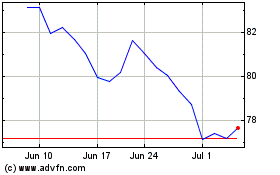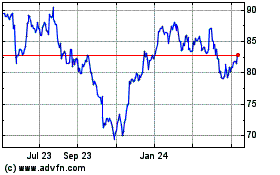Medtronic TYRX(TM) Antibacterial Envelope Reduces Cardiac Device Infection Rates at 12 Months
May 15 2015 - 1:30PM


Long-term
Citadel/Centurion Clinical Trial Findings and Independent Data
Presented at Heart Rhythm Society 36th Annual
Scientific Sessions
DUBLIN and BOSTON - MAY 15,
2015 - Medtronic plc (NYSE: MDT) today announced that its
TYRX(TM) Antibacterial Envelope reduces major cardiac device site
infections by 80 percent, up to 12 months after implantation. These
data were presented at Heart Rhythm 2015, the Heart Rhythm
Society's 36th Annual
Scientific Sessions in Boston.
The Citadel/Centurion Clinical Trials are the
first prospective, multicenter studies to evaluate the impact of
the TYRX Antibacterial Envelope on cardiac implantable electronic
device (CIED) major infections and mechanical complication rates
following implantation in high-risk patients. The results show a
low rate of surgical site infection at 12 months (0.44 percent) in
the 1,129 patients who received the TYRX Antibacterial
Envelope compared with a control group of similar patients reported
in previously published literature1 who did not
receive an envelope (2.2 percent; p=0.0023).
CIED infections are associated with substantial
morbidity, mortality and cost2,3,4 and
are increasing in frequency. The average cost of a CIED infection
in the United States is estimated at $54,926.5
"Clinical studies show that the use of the TYRX
Envelope is associated with a significant reduction in
implant-related cardiac device site
infections," said Charles A. Henrikson, M.D., M.P.H.,
FHRS, chief of electrophysiology at Oregon Health & Science
University in Portland. "These new findings reveal that the TYRX
Envelope decreases the rate of infections that can occur within the
first year after implantation. This is very good news for patients,
especially given the associated mortality and costs tied to CIED
infection."
12-Month Results of Citadel/Centurion Clinical
Trials
The Citadel/Centurion Clinical Trials enrolled 1,129 patients at 55
centers in the United States. Study participants were at high risk
for infection because they were undergoing a CIED replacement
procedure with either an implantable cardioverter-defibrillator
(ICD) (Citadel) or a cardiac resynchronization therapy (CRT) device
(Centurion). Primary endpoints were major CIED infection (involving
any site other than skin or subcutaneous tissue of the incision, or
endocarditis) and CIED mechanical complication over 12 months of
follow-up. The frequency of CIED mechanical complications in
patients implanted with the TYRX Envelope was low.
"These data support the long-term safety and
efficacy of the TYRX Envelope and showcase the clinical benefit of
this novel technology for cardiac device patients at increased risk
for infection," said Marshall Stanton, M.D., vice president and
general manager of the Tachycardia business, which is part of the
Cardiac and Vascular Group at Medtronic.
Results of Independent Study of TYRX(TM)
Absorbable Antibacterial Envelope
Additionally at Heart Rhythm 2015, researchers at Vanderbilt
University Medical Center independently reported that the TYRX(TM)
Absorbable Antibacterial Envelope was associated with a very low
incidence of CIED-related infection in a high-risk population,
comparable to that seen with the original non-absorbable TYRX
Antibacterial Envelope.
"Our study is the first-of-its-kind, comparing the
incidence of major cardiac device-related infection in high-risk
patients who, during implantation, received either the TYRX
Absorbable Envelope or the non-absorbable Envelope, with a control
group of patients who did not receive a TYRX envelope," said
Christopher R. Ellis, M.D., FHRS, FACC, principal investigator of
the study and assistant professor of medicine at Vanderbilt
University Medical Center. "After a minimum of three months,
results showed only one reported infection in the 488 patients who
received either the original or newer, absorbable TYRX Envelope,
compared with 20 infections in the control group of 638 patients.
Additionally, it was encouraging to find no difference in infection
rates between the original TYRX Envelope and the newer, fully
absorbable version."
About CIED Infections
CIED infections occur in 1-7 percent6 of all CIED
patients and about 3 percent of high-risk patients. High-risk
patients include those patients with diabetes, with a previous
history of infection, having a revision or upgrade procedure, or
with renal failure or congestive heart failure. Most CIED site
infections occur within the first three months. However, bacteria
introduced during the implant can lay dormant in the subcutaneous
pocket that houses the device under the skin and cause a delayed
infection six months or more after implantation.
About the TYRX Antibacterial Envelope
The TYRX Antibacterial Envelope is a mesh envelope that holds an
implantable cardiac device and is designed to stabilize the device
after implantation while releasing two antimicrobial agents,
minocycline and rifampin, over a minimum of seven days to help
reduce surgical-site infections.
The TYRX Absorbable Antibacterial Envelope is
fully absorbed by the body approximately nine weeks after
implantation. Both TYRX Envelopes are FDA-cleared and have received
CE Mark and are available in the United States and Europe.
In collaboration with leading clinicians,
researchers and scientists worldwide, Medtronic offers the broadest
range of innovative medical technology for the interventional and
surgical treatment of cardiovascular disease and cardiac
arrhythmias. The company strives to offer products and services
that deliver clinical and economic value to healthcare consumers
and providers around the world.
About Medtronic
Medtronic plc (www.medtronic.com), headquartered in Dublin,
Ireland, is the global leader in medical technology - alleviating
pain, restoring health and extending life for millions of people
around the world.
Any forward-looking statements
are subject to risks and uncertainties such as those described in
Medtronic's periodic reports on file with the Securities and
Exchange Commission. Actual results may differ materially from
anticipated results.
- end -
1 Gould,
et al. Outcome of advisory implantable cardioverter-defibrillator
replacement: one-year follow-up. Heart Rhythm,
2008; 5(12):1675-81.
2 Sohail
MR, Henrikson CA, Braid-Forbes MJ, et al. Mortality and cost
associated with cardiovascular implantable electronic device
infections. Arch Intern Med 2011;
171:1821-1828.
3 Le KY,
Sohail MR, Friedman PA, Uslan DZ, et al. Impact of timing of device
removal on mortality in patients with cardiovascular implantable
electronic device infections. Heart Rhythm
2011; 8: 1678-1685.
4 Habib A,
Le KY, Baddour LM, et al. Predictors of mortality in patients with
cardiovascular implantable electronic device infections. Am J Cardiol 2013; 111:874-879.
5Shariff
N, Eby E, Adelstein E, et al. J Cardiovasc
Electrophysiol. Health and Economic Outcomes Associated with Use of
an Antimicrobial Envelope as a Standard of Care for Cardiac
Implantable Electronic Device Implantation. 2015 Apr 6. doi:
10.1111/jce.12684. [Epub ahead of print]
6 Tarakji
KG, Chan EJ, Cantillon DJ, et al. Cardiac
implantable electronic device infections: presentation, management,
and patient outcomes. Heart Rhythm. 2010
Aug;7(8):1043-7.
Contacts:
Tracy McNulty
Public Relations
+1-763-526-2494
Jeff Warren
Investor Relations
+1-763-505-2696
This
announcement is distributed by NASDAQ OMX Corporate Solutions on
behalf of NASDAQ OMX Corporate Solutions clients.
The issuer of this announcement warrants that they are solely
responsible for the content, accuracy and originality of the
information contained therein.
Source: Medtronic plc via Globenewswire
HUG#1921742
Medtronic (NYSE:MDT)
Historical Stock Chart
From Mar 2024 to Apr 2024

Medtronic (NYSE:MDT)
Historical Stock Chart
From Apr 2023 to Apr 2024
